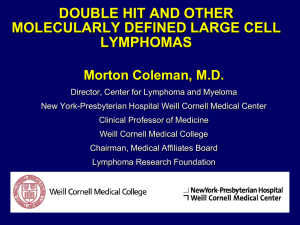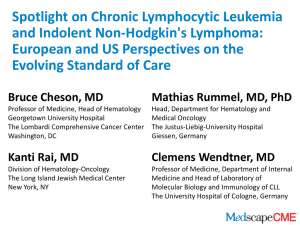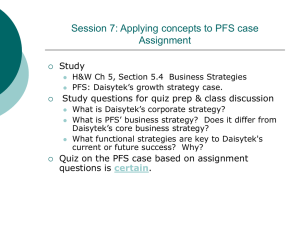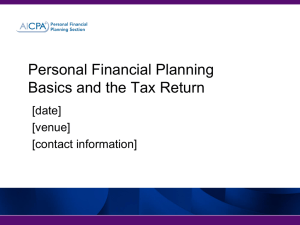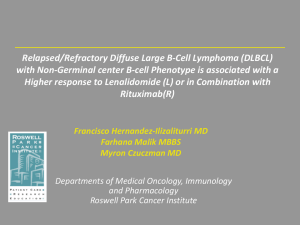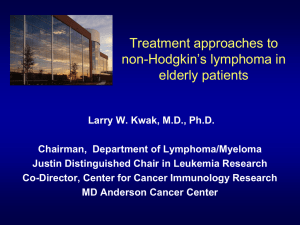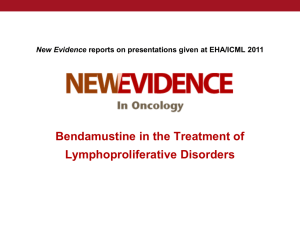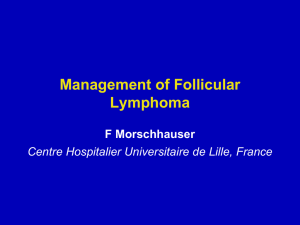Powerpoint - NewEvidence.com
advertisement
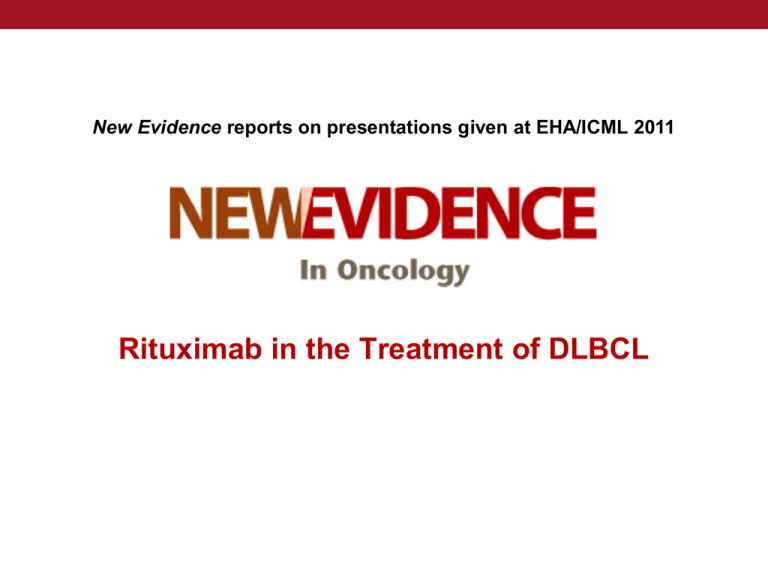
New Evidence reports on presentations given at EHA/ICML 2011 Rituximab in the Treatment of DLBCL Report on EHA/ICML 2011 presentations Treatment of limited-stage DLBCL can be effectively tailored using a PET-based approach (Sehn LH, et al. ICML 2011: Abstract 028) A phase II study of CT-011 after AuSCT in recurrent/refractory DLBCL (Gordon L, et al. ICML 2011: Abstract 063) Randomized phase II study of R-CHOP plus enzastaurin vs. R-CHOP in the first-line treatment of patients with intermediate and high-risk DLBCL (Hainsworth JD, et al. ICML 2011: Abstract 074) Lower dose intensity chemoimmunotherapy in very elderly patients with DLBCL (Vassilakopoulos T, et al. EHA 2011: Abstract 1045) DLBCL = diffuse large B-cell lymphoma; AuSCT = autologous stem cell transplantation; PET = positron emission tomography; R-CHOP = rituximab, cyclophosphamide, vincristine, prednisone. Treatment of limited-stage DLBCL can be effectively tailored using a PET-based approach Sehn LH, et al. ICML 2011: Abstract 028 Background Since 2005, patients in B.C. with limited-stage DLBCL have been treated according to a PET-based algorithm. Following three cycles of R-CHOP, patients undergo 18F-FDG-PET/CT scan. Those who are PET-negative receive one additional cycle of R-CHOP and those who are PET-positive receive IFRT. Sehn and colleagues presented an update of this ongoing experience at ICML 2011.1 1. Sehn LH, Savage KJ, Hoskins P, et al. Ann Oncol (ICML Annual Meeting Abstracts) 2011;22:Abstract 028. DLBCL = diffuse large B-cell lymphoma; PET = positron emission tomography; R-CHOP = rituximab, cyclophosphamide, vincristine, prednisone; FDGPET/CT = 18F-fluorodeoxyglucose-positron emission tomography/computed tomography; IFRT = involvedfield radiotherapy. Study design The goal of this study was to review the outcomes of all patients in the B.C. Cancer Agency Lymphoid Cancer database treated with the PET-based algorithm. The database was used to identify all patients with limitedstage DLBCL treated with this PET-based approach between March 2005 and June 2010. Patients with primary CNS, primary testicular, and transformed lymphoma were excluded. FDG-PET/CT scans were performed at a single centre 14– 21 days after three cycles of the standard three-weekly schedule of R-CHOP. Sehn LH, et al. ICML 2011: Abstract 028. DLBCL = diffuse large B-cell lymphoma; PET = positron emission tomography; R-CHOP = rituximab, cyclophosphamide, vincristine, prednisone; FDG-PET/CT = 18Ffluorodeoxyglucose-positron emission tomography/computed tomography; CNS = central nervous system. Sehn LH, et al. ICML 2011: Abstract 028. Key findings A total of 134 patients were identified and their clinical characteristics were as follows: • Median age was 64 years (range: 22–88 years); • 57% were male; • 57% had stage I disease; 43% had stage II disease; • 3% had PS >1; • 11% had elevated LDH; • 51% had at least one extranodal site; • 32% had mass size ≥5 cm; • 20% had a stage-modified IPI risk score of 0. 49% had an IPI of 1; • 23% had an IPI of 2; and 8% had an IPI of 3–4. Sehn LH, et al. ICML 2011: Abstract 028. PS = performance status; LDH = lactate dehydrogenase; IPI = International Prognostic Index. Key findings (cont’d) Patient characteristics cont’d: • 51% had at least one extranodal site; • 32% had mass size ≥5 cm; • 20% had a stage-modified IPI risk score of 0. 49% had an IPI of 1; • 23% had an IPI of 2; and 8% had an IPI of 3–4. The median follow-up was 30 months (range: 3–68 months). Sehn LH, et al. ICML 2011: Abstract 028. IPI = International Prognostic Index. Key findings (cont’d) After three cycles of R-CHOP, the PET results were as follows: • PET-negative = 103 patients (77%); • PET-positive = 30 patients (22%); • PET-indeterminate = one patient (1%). Elevated serum LDH and mass size ≥5 cm were predictive of PET status (p = 0.02 and 0.001, respectively), whereas stage-adjusted IPI was of borderline significance (p = 0.08). Sehn LH, et al. ICML 2011: Abstract 028. R-CHOP = rituximab, cyclophosphamide, vincristine, prednisone; PET = positron emission tomography; LDH = lactate dehydrogenase; IPI = International Prognostic Index. Key findings (cont’d) Of the 103 PET-negative patients, 100 completed treatment with one additional cycle of R-CHOP, two patients received IFRT due to physician choice, and one patient died of toxicity before receiving any further treatment. Seven of the 103 PET-negative patients had relapsed disease (three initially localized at the original site, two local and distant, and two distant only). Three of the PET-negative relapses were delayed, occurring between 2.5 and four years after the initial diagnosis. Sehn LH, et al. ICML 2011: Abstract 028. PET = positron emission tomography; R-CHOP = rituximab, cyclophosphamide, vincristine, prednisone; IFRT = involved-field radiation therapy. Key findings (cont’d) 29 out of 30 PET-positive patients received IFRT and one patient received one additional cycle of R-CHOP alone due to concern about toxicity. • Nine of the 30 PET-positive patients had relapsed disease. • Four patients have died from their disease. The one patient with an indeterminate PET scan completed therapy with IFRT and remains in remission. The three-year estimated TTP was 85% for the entire group of patients and 92% and 60% for PET-negative and PETpositive patients, respectively. Sehn LH, et al. ICML 2011: Abstract 028. PET = positron emission tomography; IFRT = involved field radiation therapy; R-CHOP = rituximab, cyclophosphamide, vincristine, prednisone; TTP = time-to-progression. Sehn LH, et al. ICML 2011: Abstract 028. Key findings (cont’d) The three-year OS was 93% for the entire group of patients, and 96% for PET-negative and 83% for PET-positive patients, respectively. Univariate analysis revealed that age, stage, PS, and PET status were significant predictors of TTP. In a multivariate analysis where age, stage, PS, LDH, presence of extranodal involvement, mass size ≥5 cm, and PET status were controlled for, only age, PS, and PET status remained independent predictors of TTP. Sehn LH, et al. ICML 2011: Abstract 028. PET = positron emission tomography; TTP = time-to-progression; PS = performance status; LDH = lactate dehydrogenase; OS = overall survival. Sehn LH, et al. ICML 2011: Abstract 028. Key conclusions The majority of patients with limited-stage DLBCL will be PET-negative after three cycles of R-CHOP and have an excellent outcome following abbreviated R-CHOP alone, although delayed relapses have been observed. PET-positive patients who complete therapy with IFRT have a high rate of distant relapse and alternative approaches may be warranted in this subgroup. Sehn LH, et al. ICML 2011: Abstract 028. PET = positron emission tomography; DLBCL = diffuse large B-cell lymphoma; IFRT = involved field radiation therapy; R-CHOP = rituximab, cyclophosphamide, vincristine, prednisone. A phase II study of CT-011 after AuSCT in recurrent/refractory DLBCL Gordon L, et al. ICML 2011: Abstract 063 Background CT-011 is a humanized anti-PD-1 antibody. It blocks PD-1 function and enhances the activities of NK and T-cells against PD-L1-positive tumours isolated from cancer patients. It also induces effective immune-mediated tumour regression in experimental human and murine tumour models. Gordon and colleagues hypothesized that CT-011 can elicit tumour-immune control leading to favourable clinical outcomes in DLBCL patients by delaying recurrence after AuSCT. The results of their study were presented at ICML 2011.1 1. Gordon L, Weller E, Armand P, et al. Ann Oncol (ICML Annual Meeting Abstracts) 2011;22:Abstract 063. PD = program death; NK = natural killer; DLBCL = diffuse large B-cell lymphoma; AuSCT = autologous stem cell transplantation. Study design Patients were eligible for this study if they had recurrent/refractory DLBCL that was chemosensitive in pretransplant salvage therapy, and an ECOG PS of 0–1. Three doses of CT-011 were given at 1.5 mg/kg every six weeks 30–90 days following AuSCT, and patients were followed for a total of 18 months. The primary endpoint was PFS at 16 months after the first dose of CT-011 (approximately 18 months after AuSCT). Secondary endpoints included OS, event-free survival (relapse, second cancer, or death), toxicity, safety, and biological and cellular correlates. Gordon L, et al. ICML 2011: Abstract 063. DLBCL = diffuse large B-cell lymphoma; PS = performance status; AuSCT = autologous stem cell transplantation; PFS = progression-free survival; OS = overall survival. Key findings 72 patients were enrolled in this study and 71 were evaluable. • The median age was 57 years (range: 19–80 years); • 70 patients (97%) had prior rituximab treatment and six patients (8%) had radiation post-transplant; • 43 pre-transplant patients (47%) had IPI scores of 3 or 4, and 42 patients (58%) had marrow involvement. Toxicity included 14 patients with grade 3–4 neutropenia and six patients with thrombocytopenia. IPI = international prognostic index. Gordon L, et al. ICML 2011: Abstract 063. Key findings (cont’d) There were no grade 3–4 non-hematological toxicities. At the time of this analysis, 56 patients were followed for at least 18 months. Gordon L, et al. ICML 2011: Abstract 063. Gordon L, et al. ICML 2011: Abstract 063. Key findings (cont’d) The estimated 18-month PFS was 70% (95% CI: 57–79). The estimated 18-month OS was 84% (95% CI: 72–91). Increases in circulating CD8+ central memory cells (CD8+ CD62L+ CD127+) were seen as early as 24 hours following the first dose of CT-011. • This increase was subset specific, as other memory T- lymphocytes did not increase. • This increase was attributable to PD-1 blockade and the enhancement of CD8+ PD-1+ cell survival. Gordon L, et al. ICML 2011: Abstract 063. PFS = progression-free survival; OS = overall survival.; PD = program death. Gordon L, et al. ICML 2011: Abstract 063. Gordon L, et al. ICML 2011: Abstract 063. Gordon L, et al. ICML 2011: Abstract 063. Key findings (cont’d) CD4-positive effector memory cells (CD4+ CD45RO+ CD62LCCR7-) increased six weeks following the first CT011 dose. • The increase may be subset specific as it was not observed in other subsets of CD8 or CD4 memory cells. Increases in IL-7α receptor (CD127) expression in CD4 memory cell subsets were observed as early as 24 hours following the first CT-011 dose. • No changes were observed for L-selectin (CD62L), a homing receptor for leukocytes, in all tested subsets following CT011 treatment. Gordon L, et al. ICML 2011: Abstract 063. IL = interleukin. Key findings (cont’d) There were no observed changes in the peripheral levels of IFNγ or TNFα, which excludes the occurrence of the hypothetical cytokine storm. No anti-CT-011 antibodies have been detected in the sera of any of the patients treated with CT-011 in this study throughout the treatment period, as well as one and four months after the last dose of CT-011. Gordon L, et al. ICML 2011: Abstract 063. INF = interferon; TNF = tumour necrosis factor. Key conclusions Compared with historical control data, CT-011 resulted in improved PFS and OS in patients with recurrent/refractory DLBCL after AuSCT. There was acceptable toxicity and CT-011 was well tolerated. Cellular and biological data suggest peripheral increases in specific subsets of memory T-cells and upregulation of the IL7α receptor, which is pivotal for survival and maturation of memory lymphocytes. Gordon L, et al. ICML 2011: Abstract 063. DLBCL = diffuse large B-cell lymphoma; AuSCT = autologous stem cell transplantation; PFS = progression-free survival; OS = overall survival; IL = interleukin. Key conclusions (cont’d) The subset-specific increases in CD8+ central memory cells and CD4+ effector memory cells are consistent with CT011’s mechanism of action in enhancing the survival, function, and trafficking of memory lymphocytes in vitro. These data provide the first signal of clinical efficacy of an anti-PD-1 antibody in DLBCL and suggest that randomized phase III trials are warranted. Gordon L, et al. ICML 2011: Abstract 063. DLBCL = diffuse large B-cell lymphoma; PD = program death. Randomized phase II study of R-CHOP plus enzastaurin vs. R-CHOP in the first-line treatment of patients with intermediate and high-risk DLBCL Hainsworth JD, et al. ICML 2011: Abstract 074 Background ENZ is an oral serine/threonine kinase inhibitor that targets PKCβ, an enzyme that plays a pivotal role in normal B-cell signaling and survival. ENZ induces apoptosis and suppresses the proliferation of various tumour cell lines including lymphomas.1 Its clinical activity has been demonstrated in patients with DLBCL.2 At EHA 2011, Hainsworth and colleagues presented the results of a study that compared first-line treatment with RCHOP plus ENZ to standard R-CHOP.3 1. 2. 3. Morschhauser F, Seymour JF, Kluin-Nelemans HC, et al. Ann Oncol 2008;19:247-253. Robertson MJ, Kahl BS, Vose JM, et al. J Clin Oncol 2007;25:1741-1746. Hainsworth JD, Arrowsmith ER, Mccleod M, et al. Ann Oncol (ICML Annual Meeting Abstracts) 2011;22:Abstract 074. ENZ = enzastaurin; PKCβ = protein kinase Cβ; DLBCL = diffuse large B-cell lymphoma; RCHOP = rituximab, cyclophosphamide, vincristine, prednisone. Study design DLBCL patients were required to have intermediate or highrisk IPI scores (2–5). Patients were randomized in a three-to-two ratio to receive six 21-day cycles of either R-CHOP plus ENZ therapy (arm A), or R-CHOP alone (arm B). After six cycles, responders in arm A could continue singleagent ENZ as maintenance therapy, with response evaluations conducted every eight weeks. A 1,125 mg oral loading dose of ENZ was given on day 2 of each cycle followed by 500 mg ENZ daily. Hainsworth JD, et al. ICML 2011: Abstract 074. ENZ = enzastaurin; R-CHOP = rituximab, cyclophosphamide, vincristine, prednisone; IPI = international prognostic index. Study design (cont’d) Response was evaluated (according to 1999 International Working Group criteria) every eight weeks and complete restaging was performed at the end of cycle 6. The primary endpoint was PFS. Secondary objectives included ORR, CR, PR, OS, and safety. This preliminary analysis was performed after all patients had completed R-CHOP chemotherapy, and had been followed for at least one year. Hainsworth JD, et al. ICML 2011: Abstract 074. PFS = progression-free survival; ORR = overall response rate; CR = complete response; PR = partial response; OS = overall survival; R-CHOP = rituximab, cyclophosphamide, vincristine, prednisone. Key findings 57 patients were enrolled in arm A and 43 were enrolled in arm B. Patient characteristics were comparable in both arms. A total of 65 patients (65%) had either high-intermediate (44%) or high (21%) IPI risk scores. The median PFS has not yet been reached; however, the one-year PFS rate for arm A was 73% (CI: 0.60–0.85) and 52% in arm B (CI: 0.35–0.69). Hainsworth JD, et al. ICML 2011: Abstract 074. PFS = progression-free survival; IPI = International Prognostic Index. Hainsworth JD, et al. ICML 2011: Abstract 074. Key findings (cont’d) Patients in arms A or B with an IPI risk score of 2 did not have a statistically significant difference in PFS, however patients treated in arm A with an IPI risk score of 3–5 had a significantly better PFS than patients in arm B with an IPI risk score of 3–5. The two-year OS rates were not significantly different for arm A (75%) and arm B (68%). ORR for arms A and B were 80.4% and 83.3%, respectively, and CR rates (CR + CRu) were 35.7% and 26.2%. Hainsworth JD, et al. ICML 2011: Abstract 074. PFS = progression-free survival; IPI = International Prognostic Index; CR = complete response; CRu = unconfirmed CR; ORR = overall response rate; OS = overall response. Hainsworth JD, et al. ICML 2011: Abstract 074. Hainsworth JD, et al. ICML 2011: Abstract 074. Hainsworth JD, et al. ICML 2011: Abstract 074. Key findings (cont’d) The most frequently observed grade 3–4 AEs were neutropenia (46% vs. 46% in arms A and B, respectively) and leukopenia (19% vs. 21%). In arm A, four patients died (two from sepsis, one from pulmonary embolism, and one from acute respiratory distress syndrome), and in arm B two patients died (both from sepsis). Hainsworth JD, et al. ICML 2011: Abstract 074. AE = adverse event. Hainsworth JD, et al. ICML 2011: Abstract 074. Key conclusions This preliminary analysis suggests an improvement in PFS and CR for patients with intermediate- or high-risk DLBCL treated with R-CHOP plus ENZ when compared with RCHOP alone. No difference in OS was observed at the time of analysis, but continued monitoring is ongoing. Toxicity profiles were comparable between the two treatment arms. A final analysis will be conducted after all patients have been followed for at least two years. Hainsworth JD, et al. ICML 2011: Abstract 074. PFS = progression-free survival; CR = complete response; OS = overall response; ENZ = enzastaurin; R-CHOP = rituximab, cyclophosphamide, vincristine, prednisone. Lower dose intensity chemoimmunotherapy in very elderly patients with DLBCL Vassilakopoulos T, et al. EHA 2011: Abstract 1045 Background The optimal treatment of very elderly patients with DLBCL has not been well established. Many patients have received chemotherapy without anthracyclines and this may adversely affect outcomes. R-CHOP has greatly improved the prognosis of DLBCL. The administration of rituximab in very elderly patients might permit dose reductions in the chemotherapy regimen without significant loss in efficacy. Vassilakopoulos T, et al. EHA 2011: Abstract 1045. DLBCL = diffuse large B-cell lymphoma; RCHOP = rituximab, cyclophosphamide, vincristine, prednisone. Background (cont’d) At EHA 2011, Vassilakopoulos and colleagues described the clinical characteristics of very elderly patients with DLBCL, the actual delivered doses of chemoimmunotherapy drugs in routine clinical practice, and the final outcomes in these patients.1 1. Vassilakopoulos T, Papageoirgiou P, Angelopoulou M, et al. EHA 2011: Abstract 1045. DLBCL = diffuse large B-cell lymphoma. Study design This was a retrospective study conducted in five medical centres. Comparisons were made amongst the following age groups: very elderly (≥80 years), elderly (61–70 years), and younger (≤60 years). Among 579 patients with DLBCL treated with R-CHOP or similar regimens, 56 were older than 80 years (10%). Clinical and laboratory characteristics of these patients were studied and compared with the 523 patients younger than 80 years, who were treated during the same period. Vassilakopoulos T, et al. EHA 2011: Abstract 1045. DLBCL = diffuse large B-cell lymphoma; R-CHOP = rituximab, cyclophosphamide, vincristine, prednisone. Study design (cont’d) The parameters evaluated included: gender, IPI risk factors, B-symptoms, anemia, lymphocytopenia, albumin, PFS, and OS. Additionally, the investigators studied the RDI of the four drugs (except corticosteroids) that was actually delivered to the very elderly patients. • The reference points were the doses and time intervals of standard R-CHOP given every 21 days. Endpoints included EFS including any event of relapse, progression or toxic death, and OS including death for any reason. Vassilakopoulos T, et al. EHA 2011: Abstract 1045. IPI = International Prognostic Index; PFS = progression-free survival; OS = overall survival; RDI = relative dose intensity; EFS = event-free survival; R-CHOP = rituximab, cyclophosphamide, vincristine, prednisone. Key findings The median age of the very elderly patients was 82.5 years (range: 80–91 years). The frequency of adverse prognostic factors (high IPI, poor R-IPI, low serum albumin, severe lymphocytopenia) was significantly higher in very elderly patients compared with the younger patient group (≤60 years). • In contrast, the characteristics of patients aged 61–79 and ≥80 years were similar. Vassilakopoulos T, et al. EHA 2011: Abstract 1045. IPI = International Prognostic Index; R-IPI = revised IPI. Key findings (cont’d) The five-year EFS was 81%, 68%, and 62% (p = 0.0005) in the group of ≤60, 61–79, and ≥80 year-old patients, respectively (p = 0.12 for 61-79 vs. ≥80). The corresponding five-year OS was 90%, 65%, and 55% for the three groups, respectively (p <0.0001, but p = 0.048 for 61–79 vs. ≥80). In a multivariate analysis of PFS, age ≥80 years had no independent prognostic significance when IPI and lymphocytopenia were taken into account. Vassilakopoulos T, et al. EHA 2011: Abstract 1045. PFS = progression-free survival; EFS = eventfree survival; OS = overall survival; IPI = International Prognostic Index. Vassilakopoulos T, et al. EHA 2011: Abstract 1045. Vassilakopoulos T, et al. EHA 2011: Abstract 1045. Key findings (cont’d) On the contrary, age ≥80 years was an independent prognostic factor for OS with a relative risk of 2.9 (p <0.001) and 2.1 (p = 0.01) compared with patients <80 years or 61–79 years, respectively. Among patients ≥80 years old who received more than one cycle of anthracycline-based chemotherapy, the median RDI for rituximab was 85% (IQR: 78–99%), 76% for cyclophosphamide (IQR: 67–86%), 60% for anthracycline (IQR: 50–69%), and 64% for vincristine (IQR: 50–76%). Moreover, six out of 56 patients did not receive anthracyclines, and two received only one cycle. Vassilakopoulos T, et al. EHA 2011: Abstract 1045. OS = overall survival; RDI = relative dose intensity; IQR = interquartile range. Vassilakopoulos T, et al. EHA 2011: Abstract 1045. Key conclusions Anthracycline-containing chemotherapy results in prolonged survival in >50% of DLBCL patients who are older than 80 years. These results are very encouraging, even though RDI for chemotherapeutic drugs was reduced in clinical practice. Very advanced age (≥80 years) was an independent prognostic factor for OS but not EFS. These observations suggest that the majority of very elderly patients with DLBCL should not be treated with palliative approaches, but they should receive an adjusted R-CHOPlike chemotherapeutic regimen with curative intent. DLBCL = diffuse large B-cell lymphoma; R-CHOP = rituximab, cyclophosphamide, vincristine, prednisone; RDI = relative dose intensity; OS = overall survival; EFS = event-free survival. Vassilakopoulos T, et al. EHA 2011: Abstract 1045.
